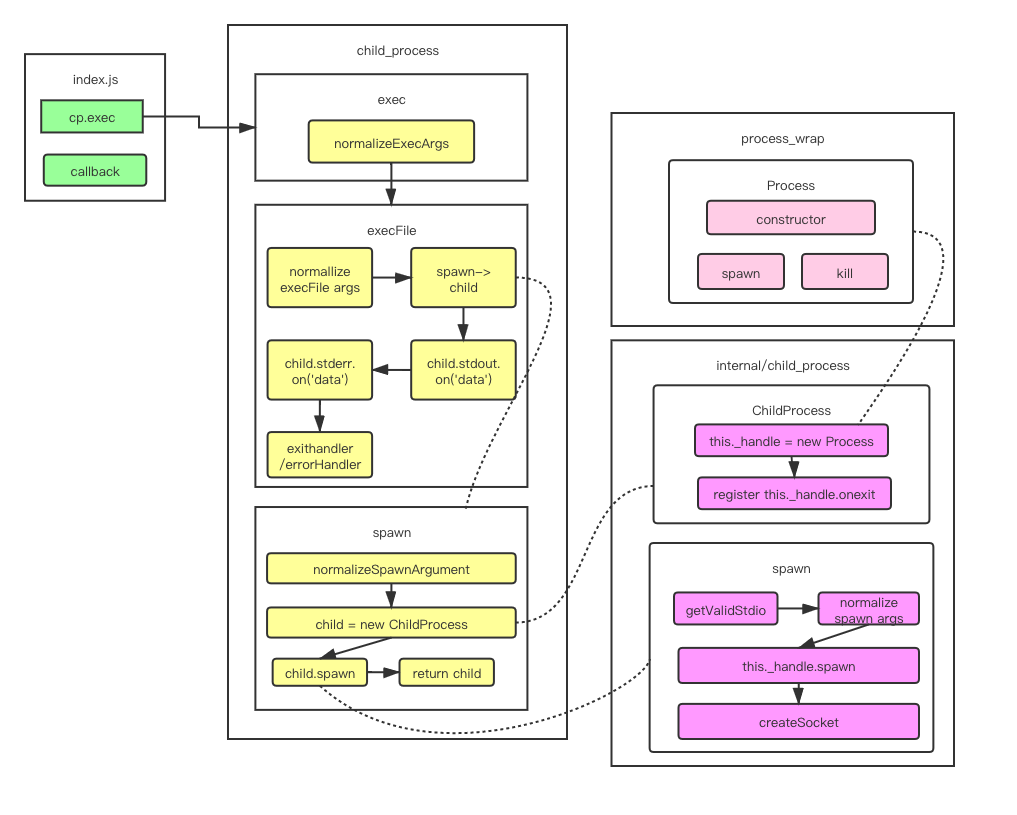[加餐] Node 进阶: child_process 源码分析
1. Node多进程child_process库exec方法源码执行流程分析
疑问和收获:
- exec和execFile到底有什么区别?
- 为什么exec/execFile/fork都是通过spawn实现的,spawn的作用到底是什么?
- 为什么spawn调用后没有回调,而exec和execFile能够回调?
- 为什么spawn调用后需要手动调用child.stdout.on('data',callback),这里的child.stdout/child.stderr到底是什么?
- 为什么有data/error/exit/close这么多种回调,他们的执行顺序到底是怎样的?
exec 源码深入分析

在未学习exec源码之前,我们先对上面的拓扑图进行一个简单的学习,看到exec内部的执行流程 不难看到exec执行的是execlFile这个方法,且不同的地方就是传入的参数不同,而execFile执行的是spawn这个方法,且spawn这个方法调用的是node内部库的一个child_process方法。
我们在webstorm中打开一个项目
// /bin/process/index.js
const cp = require('child_process')
const path = require('path')
cp.exec('ls -al|grep node_modules ',function(err,stdout,stderr){
console.log(err)
console.log(stdout)
console.log(stderr)
})
第五行代码打断点,配置webstorm调试设置后,执行命令(我这里是liugezhou-test),进入到exec源码
function exec(command, options, callback) {
const opts = normalizeExecArgs(command, options, callback);
return module.exports.execFile(opts.file,
opts.options,
opts.callback);
}
正如上面拓扑图画的那样,首先执行一个normalLizeExecArgs方法,然后调用execFile这个方法
function execFile(file /* , args, options, callback */) {
………………
const child = spawn(file, args, {
cwd: options.cwd,
env: options.env,
gid: options.gid,
uid: options.uid,
shell: options.shell,
windowsHide: !!options.windowsHide,
windowsVerbatimArguments: !!options.windowsVerbatimArguments
});
………………
function exithandler(code, signal) {
………………
callback(ex, stdout, stderr);
}
function errorhandler(e) {
………………
exithandler();
}
if (child.stdout) {
………………
}
if (child.stderr) {
………………
}
child.addListener('close', exithandler);
child.addListener('error', errorhandler);
return child;
}
上面代码的4行,我们看到调用了spawn方法。
function spawn(file, args, options) {
const opts = normalizeSpawnArguments(file, args, options);
const child = new ChildProcess();
……………………
child.spawn({
file: opts.file,
args: opts.args,
cwd: options.cwd,
windowsHide: !!options.windowsHide,
windowsVerbatimArguments: !!options.windowsVerbatimArguments,
detached: !!options.detached,
envPairs: opts.envPairs,
stdio: options.stdio,
uid: options.uid,
gid: options.gid,
serialization: options.serialization,
});
return child;
}
spawn方法的第2行如拓扑图所示,对参数执行了normalizeSpawnArguments方法,这里通过调试查看参数,发现,opts这个对象的file为 'bin/sh',这里涉及到一个重要的知识点:
shell的使用
- 直接执行shell文件: /bin/sh test.shell
- 直接执行shell语句: /bin/sh -c "ls -al|grep node_modules"
spawn方法的第3行 const child = new ChildProcess 通过分析,我们知道这个ChildProcess调用的是内部库 internal/child_process的this._handler,再进一步如拓扑图所示,调用的是c++文件,不做继续跟踪。 继续往后该方法第6行,spwan方法调用的child.spwan如拓扑图所示,真正调用的是internal/child_process中的spawn-->this._hanlde.spawn方法,该方法执行完毕后,子进程便开启了.
在spwan最后返回child后,我们再返回到execFile中,发现child.stdout与child.stderr方法的输出,以及回调f unction exithandler和errorhandler
上面就是对exec源码的略读过程。
2. 高能:child_process库exec源码精度
上一节我们阅读了exec源码的第一遍,对答题流程有了认识,这节开始阅读第二遍,进行细节的解读。
首先进入到exec的normalizeExecArgs方法,逻辑简单。
function normalizeExecArgs(command, options, callback) {
if (typeof options === 'function') { //判断options是否为function,这一步是对参数的兼容以及参数左移动
callback = options;
options = undefined;
}
// Make a shallow copy so we don't clobber the user's options object.
options = { ...options };
options.shell = typeof options.shell === 'string' ? options.shell : true;
return {
file: command,
options: options,
callback: callback
};
}
然后我们进入到execFile中,分析流程写入到下面代码之中:
// liugehou:此方法只接受了一个参数file,后面的参数通过arguments获取
function execFile(file /* , args, options, callback */) {
// liugezhou:参数初始化
let args = [];
let callback;
let options;
// Parse the optional positional parameters.
let pos = 1;
//liugezhou:意图为拿到arguments的第一个参数,即options,且需满足options为数组时(显然exec进来不满足这个条件)
if (pos < arguments.length && ArrayIsArray(arguments[pos])) {
args = arguments[pos++];
//liugezhou:对exec来说arguments[1]传入的为 {shell:true},即也不满足这个条件
} else if (pos < arguments.length && arguments[pos] == null) {
pos++;
}
// liugezhou:如上一注释,这里是满足的,将{shell:true}赋值给optios
if (pos < arguments.length && typeof arguments[pos] === 'object') {
options = arguments[pos++];
} else if (pos < arguments.length && arguments[pos] == null) {
pos++;
}
//liugezhou:满足
if (pos < arguments.length && typeof arguments[pos] === 'function') {
callback = arguments[pos++];
}
if (!callback && pos < arguments.length && arguments[pos] != null) {
throw new ERR_INVALID_ARG_VALUE('args', arguments[pos]);
}
options = {
encoding: 'utf8', //liugezhou:编码格式
timeout: 0, //liugezhou:超时时间
maxBuffer: MAX_BUFFER,//liugezhou:缓存区输出的字符串最多的容量(stdout的时候会用到)
killSignal: 'SIGTERM',
cwd: null,
env: null,
shell: false,
...options
};
// Validate the timeout, if present.
validateTimeout(options.timeout); //liugezhou:判断是否为int,如果不是抛出异常
// Validate maxBuffer, if present.
validateMaxBuffer(options.maxBuffer); //liugezhou:判断是否为number,如果不是抛出异常
options.killSignal = sanitizeKillSignal(options.killSignal);
const child = spawn(file, args, {
cwd: options.cwd,
env: options.env,
gid: options.gid,
uid: options.uid,
shell: options.shell,
windowsHide: !!options.windowsHide,
windowsVerbatimArguments: !!options.windowsVerbatimArguments
});
………………
上面代码走到51行后,进入spawn源码
function spawn(file, args, options) {
// liugezhou:继续对进来的参数进行一个解析,主要就是参数的处理解析
const opts = normalizeSpawnArguments(file, args, options);
//liugezhou:这里进入到internal/child_process文件下,重点执行this.handle = new Process()
const child = new ChildProcess();
options = opts.options;
debug('spawn', opts.args, options);
//liugezhou:又一个重点,这里的源码底层实现,分析在下一节
child.spawn({
file: opts.file,
args: opts.args,
cwd: options.cwd,
windowsHide: !!options.windowsHide,
windowsVerbatimArguments: !!options.windowsVerbatimArguments,
detached: !!options.detached,
envPairs: opts.envPairs,
stdio: options.stdio,
uid: options.uid,
gid: options.gid,
serialization: options.serialization,
});
return child;
}
3. 深度分析child_process库spawn底层实现
接着上一节代码块中走到了child.spawn:
- 第一步是通过getValidStdio去生成pipe,创建一个管道实例:第一个是输入,第二个是输出,第三个是error(只是生成了管道,但是还没创建socket的通信)
- 第二步对spawn的一些参数进行处理:下面代码未贴
- 第三步通过this._handle.spawn 子进程被创建出来
- 第四步通过createSocket方法,将之前的pipe和子进程与socket绑定。
ChildProcess.prototype.spawn = function(options) {
………………
//liugezhou:'pipe'管道从这里创建,这里面的代码就不贴了,该代码可以:
//1. stdio可以传入ignore,静默执行,没有输出
stdio = getValidStdio(stdio, false);
………………
//liugezhou:经过这步后,子进程立即被创建出来
const err = this._handle.spawn(options);
……………
// liugezhou:此循环非常重要,建立起来了父进程与子进程的socket通信
for (i = 0; i < stdio.length; i++) {
………………
if (stream.handle) {
// When i === 0 - we're dealing with stdin
// (which is the only one writable pipe).
//liugezhou:createSocket
stream.socket = createSocket(this.pid !== 0 ?
stream.handle : null, i > 0);
//liugezhou:到这里就得到了一个socket事例
if (i > 0 && this.pid !== 0) {
this._closesNeeded++;
stream.socket.on('close', () => {
maybeClose(this);
});
}
}
}
………………
return err;
};
然后我们再返回到execFile中,接着往下走:
function execFile(file /* , args, options, callback */) {
………………
let encoding;
//liugezhou:等待输入输出流全部执行完毕后,最后生成内容的数组,这个_stdout是一次性push给我们的,所以这也是我们前面学习说为什么进行耗时任务的时候,不要使用execFile
const _stdout = [];
const _stderr = [];
if (options.encoding !== 'buffer' && Buffer.isEncoding(options.encoding)) {
encoding = options.encoding;
} else {
encoding = null;
}
//定义了一些变量
………………
function exithandler(code, signal) {
if (exited) return;
exited = true;
if (timeoutId) {
clearTimeout(timeoutId);
timeoutId = null;
}
if (!callback) return;
// merge chunks
let stdout;
let stderr;
if (encoding ||
(
child.stdout &&
child.stdout.readableEncoding
)) {
stdout = _stdout.join('');
} else {
stdout = Buffer.concat(_stdout);
}
if (encoding ||
(
child.stderr &&
child.stderr.readableEncoding
)) {
stderr = _stderr.join('');
} else {
stderr = Buffer.concat(_stderr);
}
if (!ex && code === 0 && signal === null) {
callback(null, stdout, stderr);
return;
}
if (args.length !== 0)
cmd += ` ${args.join(' ')}`;
if (!ex) {
// eslint-disable-next-line no-restricted-syntax
ex = new Error('Command failed: ' + cmd + '\n' + stderr);
ex.killed = child.killed || killed;
ex.code = code < 0 ? getSystemErrorName(code) : code;
ex.signal = signal;
}
ex.cmd = cmd;
callback(ex, stdout, stderr);
}
function errorhandler(e) {
ex = e;
if (child.stdout)
child.stdout.destroy();
if (child.stderr)
child.stderr.destroy();
exithandler();
}
………………
//liugezhou:timeout耗时的操作
if (options.timeout > 0) {
………………
}
if (child.stdout) {
if (encoding)
child.stdout.setEncoding(encoding);
child.stdout.on('data', function onChildStdout(chunk) {
const encoding = child.stdout.readableEncoding;
const length = encoding ?
Buffer.byteLength(chunk, encoding) :
chunk.length;
stdoutLen += length;
if (stdoutLen > options.maxBuffer) {
const truncatedLen = options.maxBuffer - (stdoutLen - length);
_stdout.push(chunk.slice(0, truncatedLen));
ex = new ERR_CHILD_PROCESS_STDIO_MAXBUFFER('stdout');
kill();
} else {
_stdout.push(chunk);
}
});
}
if (child.stderr) {
if (encoding)
child.stderr.setEncoding(encoding);
child.stderr.on('data', function onChildStderr(chunk) {
const encoding = child.stderr.readableEncoding;
const length = encoding ?
Buffer.byteLength(chunk, encoding) :
chunk.length;
stderrLen += length;
if (stderrLen > options.maxBuffer) {
const truncatedLen = options.maxBuffer - (stderrLen - length);
_stderr.push(chunk.slice(0, truncatedLen));
ex = new ERR_CHILD_PROCESS_STDIO_MAXBUFFER('stderr');
kill();
} else {
_stderr.push(chunk);
}
});
}
child.addListener('close', exithandler);
child.addListener('error', errorhandler);
return child;
}
4. child_process事件应用方法详解
本节我们进入到child_process源码的第三轮,彻底搞懂process的回调流程,也是child_process中最复杂的部分。同样,我们通过processOn图对流程进行梳理一遍:
在分析了上面流程后,我们先写一些测试代码以理解上面的流程。
const cp = require('child_process')
const path = require('path')
const child = cp.exec('ls -al|grep node_modules',function(err,stdout,stderr){
console.log('callback--------start')
console.log(stdout)
console.log('callback--------end')
})
child.stdout.on('data',(chunk)=>{
console.log('stdout data:',chunk)
})
child.stderr.on('data',(chunk)=>{
console.log('stderr data:',chunk)
})
child.stderr.on('close',()=>{
console.log('stderr close')
})
child.on('exit',(exitCode)=>{
console.log('exit:',exitCode)
})
child.on('close',()=>{
console.log('close!')
})
5. 高难度:深度解析child_process库spawn方法回调原理
6. child_process库fork执行流程分析
7. 精化:Node多进程源码总结
exec/execFile/spawn/fork的区别
- exec: 原理是调用/bin/sh -c 执行我们传入的shell脚本,底层调用略execFile
- execFile:原理是直接执行我们传入的file和args,底层调用spawn创建和执行子进程,并建立略回调,一次性将所有的stdout和stderr结果返回
- spawn:原理是调用略internal/child_process,实例化略ChildProcess子进程对象,再调用child.spawn创建 子进程并执行命令,底层是调用了child.)handle.spawn执行process_wrap中的spwan方法,执行过程是异步的,执行完毕后再通过PIPE进行单向数据通信,通信结束后子进程发起onexit回调,同时Socket会执行close回调。
- fork:原理是通过spawn创建子进程和执行命令,采用node执行命令,通过setupchannel创建IPC用于子进程和父进程之间的双向通信。
data/error/exit/close回调的区别
- data:用于主进程读取数据过程中通过onStreamRead发起的回调
- error: 命令执行失败后发起的回调
- exit: 子进程关闭完成后发起的回调
- close:子进程所有Socket通信端口全部关闭后发起的回调
- stdout close/stderr close:特定的PIPE读取完成后调用onReadableStreamEnd关闭Socket时发起的回调。
若有收获,就点个赞吧